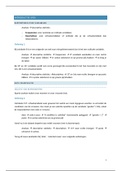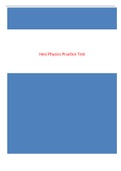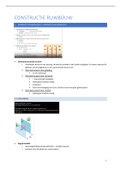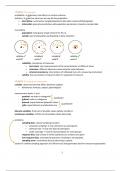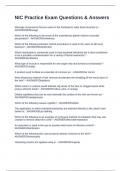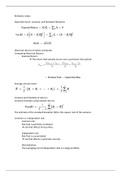2020
6EMA51 –
Characterization of
Materials
LECTURE SLIDE SUMMARY
DOORSLAER, R.F.J.F. VAN
,6EMA51 – LECTURE 1 - AFM
Crystalline & amorphous → morphology (sub-
nm to macrostructure)
- Synthetic materials: chemistry →
processing → material properties
- Structural variables: only some weight-
averaged structure obtained
o Composition, configuration,
conformation
- Morphological variables:
o number of components
o crystalline / amorphous
regions and transitions
o crystal defects (inclusions,
grain boundaries, etc.)
o phase separation (micro,
meso, macro)
o percolation (electrical, mechanical)
o inhomogeneity, hierarchical assemblies
- Sample preservation is influenced by measurement timescale → data can be different!
AFM
- SPM is microscopy that forms images of surfaces by mechanically moving a physical probe across a
sample and recording the prove-surface interaction as function of position.
o Ideal is that the tip of the probe is terminated in single atom
o Overlap of atomic orbitals of conductive material and probe → a current is found
o Constant current mode
o Constant height mode
- AFM: Cantilever scans surface. Detector records on photodiode by use of laser where the cantilever
tip is positioned. (bending up/down?)
o Cantilever is made by silicon
technology
o Face-distance curve → repulsive
and attractive (Vander Waals)
force of cantilever tip
o Static and dynamic operation
▪ Constant height mode →
non-contact mode
▪ Constant force mode
,DYNAMIC OPERATION AFM: ADDITIONAL (VIBRATING CANTILEVER) OSCILLATION
- Tapping mode principle: driven by actuator to oscillate with amplitude A0 (free vibration) near its
resonant frequency f0. The cantilever is then brought close to the specimen where it taps with a
reduced Asp (set-point amplitude).
- Resolution horizontal and vertical direction
o Horizontal: tip sharpness
o Vertical: how accurately the displacement of the cantilever can be recorded
- Force modulation mode: punches holes in the material (softness / hardness)
o Stiffness measurement → mechanical properties
- Non-contact mode for extremely soft materials
- Tapping mode for soft materials; minimal surface damage
- Contact mode: mechanical properties are probed; both soft and hard materials.
o In dynamic contact mode (force modulation mode) the cantilever tip oscillates around the
set point thus probing the mechanical properties of the sample
ADVANCED AFM
- C-AFM (conductive)
- EFM (electrostatic)
- Both are surface techniques, but these can record 3D images of the material
- Slice-by-slice principle: EFM tip has physical interaction with sample surface. A voltage is applied
between (gold-coated) back plane and the tip. Now the current or V-drop between front and back of
sample can be measured.
o Cut off a thin nm-layer so you can build up 3D representation
, - TERS: Tip Enhanced Raman Spectroscopy
combines confocal microscope with
scanning probe microscope. A gold (highly
conductive) tip is used → electromagnetic
radiation can let Raman focus on very
small volumes. The gold tip largely
enhances Raman resolution.
- SNOM: Scanning Near-Field OM uses a light probe
placed at a distance much smaller than the
wavelength to the sample surface. Image is formed
by scanning the probe over the surface.
SUMMARY SPM
- Surface techniques
- AFM has static and dynamic modes and can be carried out in liquids.
- AFM resolution is dependent on sharpness of tip (horizontal) and reaches sub-0.1 nm level (vertical)
- AFM can probe:
o Surface topography (height image)
o Surface interactions (phase image)
o Mechanical properties (force image)
o Conductive properties (C-AFM)
o Chemical composition (TERS)
o Optical properties (SNOM)
- Imaging of volumes by sequential sectioning and surface imaging.
- Sample preparation relatively simple, e.g. by dispersing / adsorbing materials on support.
6EMA51 –
Characterization of
Materials
LECTURE SLIDE SUMMARY
DOORSLAER, R.F.J.F. VAN
,6EMA51 – LECTURE 1 - AFM
Crystalline & amorphous → morphology (sub-
nm to macrostructure)
- Synthetic materials: chemistry →
processing → material properties
- Structural variables: only some weight-
averaged structure obtained
o Composition, configuration,
conformation
- Morphological variables:
o number of components
o crystalline / amorphous
regions and transitions
o crystal defects (inclusions,
grain boundaries, etc.)
o phase separation (micro,
meso, macro)
o percolation (electrical, mechanical)
o inhomogeneity, hierarchical assemblies
- Sample preservation is influenced by measurement timescale → data can be different!
AFM
- SPM is microscopy that forms images of surfaces by mechanically moving a physical probe across a
sample and recording the prove-surface interaction as function of position.
o Ideal is that the tip of the probe is terminated in single atom
o Overlap of atomic orbitals of conductive material and probe → a current is found
o Constant current mode
o Constant height mode
- AFM: Cantilever scans surface. Detector records on photodiode by use of laser where the cantilever
tip is positioned. (bending up/down?)
o Cantilever is made by silicon
technology
o Face-distance curve → repulsive
and attractive (Vander Waals)
force of cantilever tip
o Static and dynamic operation
▪ Constant height mode →
non-contact mode
▪ Constant force mode
,DYNAMIC OPERATION AFM: ADDITIONAL (VIBRATING CANTILEVER) OSCILLATION
- Tapping mode principle: driven by actuator to oscillate with amplitude A0 (free vibration) near its
resonant frequency f0. The cantilever is then brought close to the specimen where it taps with a
reduced Asp (set-point amplitude).
- Resolution horizontal and vertical direction
o Horizontal: tip sharpness
o Vertical: how accurately the displacement of the cantilever can be recorded
- Force modulation mode: punches holes in the material (softness / hardness)
o Stiffness measurement → mechanical properties
- Non-contact mode for extremely soft materials
- Tapping mode for soft materials; minimal surface damage
- Contact mode: mechanical properties are probed; both soft and hard materials.
o In dynamic contact mode (force modulation mode) the cantilever tip oscillates around the
set point thus probing the mechanical properties of the sample
ADVANCED AFM
- C-AFM (conductive)
- EFM (electrostatic)
- Both are surface techniques, but these can record 3D images of the material
- Slice-by-slice principle: EFM tip has physical interaction with sample surface. A voltage is applied
between (gold-coated) back plane and the tip. Now the current or V-drop between front and back of
sample can be measured.
o Cut off a thin nm-layer so you can build up 3D representation
, - TERS: Tip Enhanced Raman Spectroscopy
combines confocal microscope with
scanning probe microscope. A gold (highly
conductive) tip is used → electromagnetic
radiation can let Raman focus on very
small volumes. The gold tip largely
enhances Raman resolution.
- SNOM: Scanning Near-Field OM uses a light probe
placed at a distance much smaller than the
wavelength to the sample surface. Image is formed
by scanning the probe over the surface.
SUMMARY SPM
- Surface techniques
- AFM has static and dynamic modes and can be carried out in liquids.
- AFM resolution is dependent on sharpness of tip (horizontal) and reaches sub-0.1 nm level (vertical)
- AFM can probe:
o Surface topography (height image)
o Surface interactions (phase image)
o Mechanical properties (force image)
o Conductive properties (C-AFM)
o Chemical composition (TERS)
o Optical properties (SNOM)
- Imaging of volumes by sequential sectioning and surface imaging.
- Sample preparation relatively simple, e.g. by dispersing / adsorbing materials on support.



